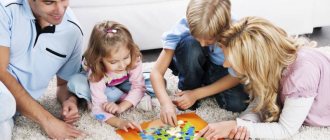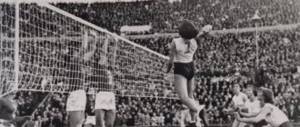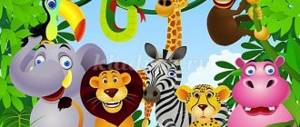Analysis of physical education classes in the senior group
Analysis of physical education classes in the senior group
1.The structure of the lesson is followed. The introductory part contains drill exercises (forming in a line, changing into a column of three), turns, various types of walking (on toes, on heels, wide strides, snake), running (with high knees, regular running). General and special preparation of the body.
In the main part, a complex with pigtails was carried out. In order to relieve physical stress, various starting positions were used
(basic stance, legs apart, kneeling stand, sitting on the floor, lying on the floor). The main types of movements were performed divided into 2 columns. The right rank reinforced the skill of jumping on two legs moving forward.
The left one was learning a movement coordination exercise. At the end of the main part, an outdoor game called “Traps” was played with ribbons.
In the final part, the instructor reduced the children’s physical activity with the low-mobility game “Entertainers.”
2. The instructor prepared sports equipment in advance (braids, balls, cubes, ribbons), and carried out cross-ventilation of the gym.
3. 19 children from the older group attended the lesson. The appearance of the instructor corresponded to the physical education lesson, but not all children were wearing physical education uniform - white top, black bottom, Czech shoes on their feet. Vasilina D., Yulia M., Lera V., Vlad B. attended the lesson in ordinary clothes.
4.Children after adoption and. counting, they perform the exercises correctly, they have developed the skill of performing basic movements. Formation exercises, such as changing into columns of three and two, are performed ineptly, many children are lost where to go.
During the educational and training session, a frontal, group method of organizing children was used, which in turn effectively affects the motor density of the lesson. In the water part, general preparation of the body (walking, running) and special muscles of the shoulder girdle and arms were used.
Taking into account the content of the exercises, the age capabilities of children 5-6 years old and the individual characteristics of children, visual and verbal methods were used for the lesson. When teaching children to maintain balance on a gymnastic bench, the instructor used visual techniques such as (showing a model), verbal techniques consisted of a brief explanation.
Multiple repetitions, different starting positions, uniform distribution of physical load on the children’s body. Physical activity was regulated in accordance with the structure of the physical education lesson. The peak load in the main part increased during the outdoor game “Traps” and decreased in the final part.
Self-analysis of physical education classes in accordance with the Federal State Educational Standard in the preparatory group.
Zhanna Lysenko
Self-analysis of physical education classes in accordance with the Federal State Educational Standard in the preparatory group.
A physical education lesson was conducted with children of the general development group , children of the seventh year of life. There are 12 people in .
Purpose of the lesson : to develop in children a positive, value-based attitude towards their own health
The program content of the lesson corresponds to the age and development of children in the preparatory group of the preschool education program “From birth to school”
edited by
N. E. Veraksy, T. S. Komarova, M. A. Vasilyeva. The goals and objectives of the lesson correspond to the content and are formulated taking into account educational areas.
The sanitary and hygienic conditions for organizing the lesson meet the requirements of SanPin: the room was ventilated in advance, the lighting was sufficient, the entire space of the gym were not used during of the lesson was taken into account . The children were dressed in lightweight sportswear and comfortable shoes.
The lesson consisted of three parts: introductory, main and final. duration : 35 minutes . When planning the lesson, the age and individual characteristics of the children were taken into account. lesson time music and the necessary physical education equipment the lesson was thought out .
Integration of educational areas: “Cognitive development”
,
“Social and communicative”
,
“Physical development”
.
Priority direction - “Physical development”
.
Topic: “Young Cosmonaut School”
.
Tasks in areas of development:
1) Objectives of “Physical Development”
:
Educational:
Strengthen various types of walking and running; with high knees; slip; race walking; with a change in tempo.
Practice maintaining balance; in hitting the ball off the floor with one hand.
Strengthen children's ability to walk on a gymnastic bench while maintaining balance and using a bag on their head.
Repeat jumping on two legs while moving forward over obstacles.
Educational:
Develop a conscious attitude towards performing movements in accordance with the text
Develop coordination of movements.
Develop creativity, independence , initiative in motor actions, and a conscious attitude towards them.
Develop endurance, agility, strength.
Educational:
Cultivate goodwill and contact in relationships with peers.
Cultivate organization, willpower, and dexterity.
2) Objectives of “Socio-communicative development”
:
Educational:
Contribute to enriching children's experience through the development of play activities.
Educational:
Develop communication and speech skills.
To develop children's attention and interest, emotional responsiveness.
Educational:
Cultivate a desire to communicate in a group of peers.
3) Objectives of “Cognitive Development”
:
Educational:
To form in children elementary ideas about goodness and mutual assistance.
Educational:
Practice the ability to correctly name the basic rules of a healthy lifestyle
Educational:
Cultivate a desire to communicate in a group of peers.
Materials and equipment: balls, gymnastic bench, sandbags, hoops, signal cards, interactive board, laptop.
Structure of a physical education lesson .
Organized educational activities were carried out with a group of children of senior preschool age 6–7 years old.
The lesson consisted of three interconnected parts, during which the children performed various actions step by step. This structure is completely justified, since each part is aimed at solving certain problems and offers a choice of methods and techniques.
The introductory part is the organization of children, motivation for upcoming activities. At the organizational stage of the lesson , a surprise moment was used. The children were invited to go on a trip to the “School of Young Cosmonaut”
.
In the first (introductory)
part of
the lesson, the task is to organize children, arouse interest and draw attention to upcoming motor tasks, create the necessary emotional mood, and also prepare the child’s body to perform more complex and intense exercises in the main part of the lesson . The content of the introductory part includes: walking (corrective, with high knees, snake, column running 1)
.
Running is done at an average pace so as not to overexcite the children. Usually running and jumping alternate with walking. All children perform the exercises in the introductory part at the same time. At the end of the introductory part, the children disperse scatteredly. 4-8 minutes are allotted for general and special .
In the second (main)
Part of
the lesson , the following tasks are solved: repetition and consolidation of what has been previously learned, improvement of children’s abilities and skills in movements, education of physical qualities. I carried out outdoor control using gymnastic sticks. The ORU complex with a gymnastic stick affects absolutely all muscle groups .
In addition, using a gymnastic stick helps develop coordination. After performing ORU, I used breathing exercises. The children's improvement of the main types of movements during the lesson took place in an individual and continuous way, the purpose of which was to develop and strengthen the leg muscles, strengthen the back muscles, develop movement coordination, prevent and correct poor posture. To achieve the set goals, sports equipment was used: a gymnastic bench, bags with sand, balls.
Outdoor game "Don't stay on the ground"
was used to develop children's orientation in movement and space, as well as to develop dexterity, reaction speed, attention, resourcefulness, and coordination of movements. After the game I used breathing exercises. The main part takes 20-25 minutes.
In the final part of the lesson , to relieve muscle tension, while listening to classical music, I used a relaxation exercise with balls (hedgehog)
.
Also in the final part of the lesson I used a technique in the form of a “Blitz game”
. The children were asked to show their acquired knowledge using signal cards.
In my work I used questions, ICT, physical education equipment - all this contributed to the effectiveness of the lesson : motor and cognitive activity of children.
The material for the lesson was selected at a level accessible to children, corresponded to their psychological characteristics and was rational for solving the set goals and objectives. The children were active, attentive, and felt comfortable. All this is confirmed by the results of our activities.
All elements of the lesson are logically united by a common theme. This structure of the lesson is completely justified . Since each part of the lesson is aimed at solving certain pedagogical problems and offers a choice of adequate methods and techniques. The content of the lesson corresponded to the assigned tasks.
Activities for the lesson are characterized as joint and individual.
During the OD process I used the following methods and techniques:
1. Verbal (questions for children, clarification, encouragement, artistic expression)
.
2. Visual demonstration
3. Practical (performing actions with objects according to instructions (sticks, balls, bags)
.
4. Gaming
5. Control methods (analysis of completed tasks was performed in the form of praise; performance results were assessed using verbal praise and criticism)
Methods include a system of techniques that are combined to solve learning problems. Techniques (explanations, instructions, demonstration, commands, play techniques, artistic expression, encouragement, helping the child, analysis) are aimed at optimizing the individual development of each child.
I believe that the form of organization of organized educational activities for children that I chose was quite effective and dynamic. I tried to comply with the norms of pedagogical ethics and tact. I think that the tasks set during the lesson were completed!
Summary of GCD on physical development in the middle group
Author: Khmarina Elena Valentinovna
Summary of GCD on physical development in the middle group
Objectives:
Educational:
Exercise children in walking one after another, in a snake, lining up in a circle, walking with high knees, and doing pull-ups on a gymnastic bench.
Developmental:
Develop agility, endurance, motor activity.
Educational:
Cultivate interest in physical development activities, a sense of mutual assistance, and a friendly attitude.
Health savings
: Strengthen the respiratory system, promote the formation of correct posture, hardening the body, and prevent flat feet.
Equipment:
Gymnastic benches, sandbags, musical accompaniment, basket with a letter, rope.
1 part.
Progress of the NOD:
Children enter the hall to the music and form a circle.
Educator:
“Do you guys like fairy tales?
(Children's answers)
Do you want to go to a fairy forest?
(Children's answers)
Let's go together along the path into the forest! “The children follow the teacher and follow each other in a circle. The music ends and the children stop.
Educator:
“Here we come to the forest. Hello forest, dense forest! Full of fairy tales and miracles! There’s a swamp ahead... How can we get through it?” Sandbags are laid out in front of the children to get through the “swamp”; children step over the bags.
Educator:
“Try to walk in such a way that you don’t go off the road.” When everyone has overcome the obstacle, the teacher picks up a pre-prepared basket with a letter in it.
Educator:
“We walked through the swamp and found the basket!” They read the letter: “There was a little house in the forest, animals lived there, and when I got to them, the little house suddenly fell down! Help! Help! Give us back the little house!”
Educator:
“Let's help the animals!
(Children's answers)
To do this, you need to find a clearing and build a tower! Go ahead! There is a river in front of us, we need to cross the bridge!” Children approach the bench.
Educator:
“There is a bridge on the way that you have to crawl along! Reach straight with your hands and grab the bridge! Don’t put your feet down, raise your head up!” Children approach the stream (rope).
Educator:
“We can’t go any further, a stream is babbling on the way! Raise your legs higher, step over the stream!” They move on like a snake.
Educator:
“There’s a clearing ahead, the sun is shining! It also helps the guys in the forest!”
Part 2.
ORU:
1.
Starting position
- legs together, hands on the belt.
Educator:
“We looked at the sun, and the rays warmed us!”
Children on their toes reach for the “sun” (4-6 times) 2. I.p - legs together, arms to the sides. Educator:
“The breeze flies by, the trees in the forest sway.” Tilt left to right (8-10 times).
3. Starting position
- legs together, arms down.
Educator:
“Look at the bottom guys, there are mushrooms growing - honey mushrooms! We must also collect them and then give them to the animals.” Bend forward (6-8 times).
Educator:
“We had a good walk and weren’t tired at all! We’ll take the tools and build a home for the animals.”
ATS:
1.
“Sawing”
-
Starting position
: arms bent at the elbows, legs apart.
We imitate the movements of a saw. 2. “Chop”
-
Starting position
of the arm above the head in a lock, legs apart.
Bend forward, swing your arms between your legs. 3. “We hammer in nails”
-
Starting position:
legs together, hands on the belt. On the count of 1,2,3,4, children perform jumps.
Educator:
“So the little mansion has grown, It is not low, not high!
Animals will live in it! Who will live there? (Children's answers.)
Children imitate the movement of animals from a fairy tale.
Part 3.
Educator: “The butterflies have arrived and warmed their wings!”
Outdoor game “Butterflies and the Sun”. (Sun - butterflies fly, rain - butterflies stop and hide their wings.)
Reflection.
Educator:
“We were all friendly, brave, skillful, and so we built a little house in a fairytale forest!
Now it’s time for us to return” comments powered by HyperComments






